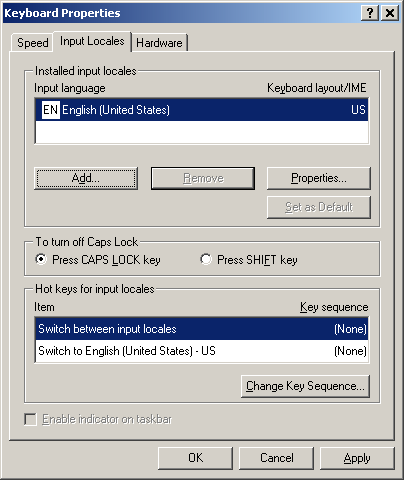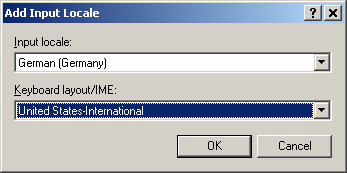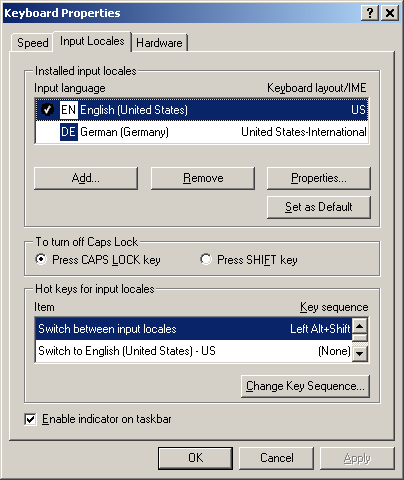
How to:
This document is available at: http://www.larosse.net/doc/kbd-howto.html. Send comments to charles@larosse.net.
So, you think there has to be a better way to enter umlauts and es-tzets than typing and memorizing those stupid alt-keypad codes? You're right, there is -- at least for Windows 2000 (and probably for other variants as well). But first, you will have to configure your keyboard.
From the Control Panel, bring up the Keyboard Properties dialogue box by double-clicking on Keyboard.
Next select the index tab labeled Input Locales. You should see a dialogue box like the one below.

Now you need to add a new locale so press the Add... button in the top group of buttons. Another dialogue box will pop up asking you to select a locale and a keyboard layout.

Select German (Germany) in the top box and United States - International in the bottom then press OK.
The Keyboard Properties dialogue should now look like this:

Take a look at the bottom group labeled Hot keys for input locales. Notice the key sequence for the first entry, Switch between input locales. This is what you will press to toggle between US and international modes. The default is Left-Alt + Shift.
Make sure the check-box at the bottom, Enable indicator on taskbar, is checked. You'll see why later.
Press the OK button. You've completed the configuration.
First, place the keyboard into international mode. Do this by pressing the Left-Alt + Shift keys. Now look down at the system tray on the right side of your taskbar. There should be a little blue DE. This is the taskbar indicator mentioned earlier.
Certain keys will now work a little differently. The " ' ` ~ ^ (quote, single-quote, grave, tilde, circumflex) keys will not echo until you press another key -- these are called dead-keys. If the next key you press is part of a recognized sequence (see the table below) then the corresponding character is echoed, otherwise both keys are echoed. For example: You press " nothing happens. You then press a now an ä is displayed. If instead you press " followed by X then "X is displayed. Here is a table of the characters you need for German:
| Symbol | Keys |
|---|---|
| ä | " a |
| Ä | " A |
| ö | " o |
| Ö | " O |
| ü | " u |
| Ü | " U |
| ß | Right-Alt + s |
Once you've had all the fun typing in German that you can handle, press Left-Alt + Shift again and the DE will change back to EN and your keyboard will return to normal.
validate